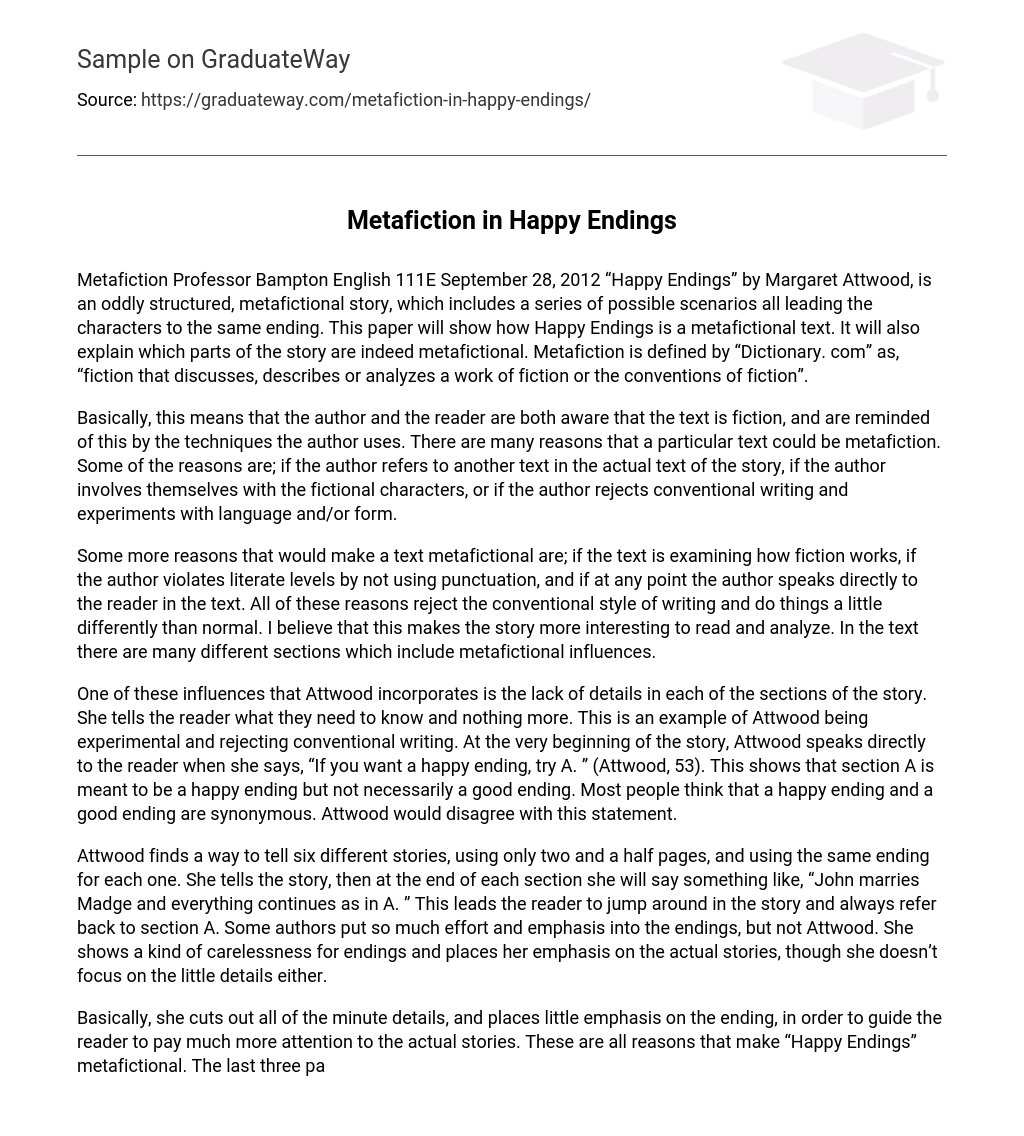“Happy Endings” by Margaret Attwood, is an oddly structured, metafictional story, which includes a series of possible scenarios all leading the characters to the same ending. This paper will show how Happy Endings is a metafictional text. It will also explain which parts of the story are indeed metafictional. Metafiction is defined by “Dictionary. com” as, “fiction that discusses, describes or analyzes a work of fiction or the conventions of fiction”.
Basically, this means that the author and the reader are both aware that the text is fiction, and are reminded of this by the techniques the author uses. There are many reasons that a particular text could be metafiction. Some of the reasons are; if the author refers to another text in the actual text of the story, if the author involves themselves with the fictional characters, or if the author rejects conventional writing and experiments with language and/or form.
Some more reasons that would make a text metafictional are; if the text is examining how fiction works, if the author violates literate levels by not using punctuation, and if at any point the author speaks directly to the reader in the text. All of these reasons reject the conventional style of writing and do things a little differently than normal. I believe that this makes the story more interesting to read and analyze. In the text there are many different sections which include metafictional influences.
One of these influences that Attwood incorporates is the lack of details in each of the sections of the story. She tells the reader what they need to know and nothing more. This is an example of Attwood being experimental and rejecting conventional writing. At the very beginning of the story, Attwood speaks directly to the reader when she says, “If you want a happy ending, try A. ” (Attwood, 53). This shows that section A is meant to be a happy ending but not necessarily a good ending. Most people think that a happy ending and a good ending are synonymous. Attwood would disagree with this statement.
Attwood finds a way to tell six different stories, using only two and a half pages, and using the same ending for each one. She tells the story, then at the end of each section she will say something like, “John marries Madge and everything continues as in A. ” This leads the reader to jump around in the story and always refer back to section A. Some authors put so much effort and emphasis into the endings, but not Attwood. She shows a kind of carelessness for endings and places her emphasis on the actual stories, though she doesn’t focus on the little details either.
Basically, she cuts out all of the minute details, and places little emphasis on the ending, in order to guide the reader to pay much more attention to the actual stories. These are all reasons that make “Happy Endings” metafictional. The last three paragraphs of the story are all Attwood speaking directly to the reader. She states… You’ll have to face it, the endings are the same however you slice it. Don’t be deluded by any other endings, they’re all fake, either deliberately fake, with malicious intent to deceive, or just motivated by excessive optimism if not by downright sentimentality.
The only authentic ending is the one provided here: John and Mary die. John and Mary die. John and Mary die. The fact that Attwood would take the opportunity to speak directly to the reader in this way shows many things about the story and the author. First and foremost, this is yet another reason that the story is metafictional. Also this shows how Attwood really does not think endings are the significant part of the story. In her opinion, you can get rid of those cheesy, “deliberately fake” endings and the little details and still have a great story.
Attwood doesn’t want the reader to look forward to what the ending is going to be while they are reading the story. The reader should be enjoying the story, not living for the ending. Attwood goes on to state how she feels about each part of the story. So much for endings. Beginnings are always more fun. True connoisseurs, however, are known to favor the stretch in between, since it’s the hardest to do anything with. This clearly states how she feels about each part of the story. I believe this seems as if she is rejecting the conventional style of writing by thinking like this and incorporating it into her writing.
This is yet another way the story is metafictional. Overall, I believe it is safe to say that “Happy Endings” by Margaret Attwood is a metafictional story. The story incorporates references from earlier in the text, guiding the reader to jump around, the author speaks directly to the reader, and the author clearly rejects the conventional writing style. These are a few of the many reasons that make this a metafictional text. And John and Mary continue their lives as in A, wait, I think I have read “Happy Endings” too many times.
Works Cited
- Attwood, Margaret. “Happy Endings. ” The Story and Its Writer. Ed. Ann Charters. Boston: Bedford/St. Martin’s, 2003. 54-56.
- Unknown. “A Story with a Happy Ending. ” Cartoon. Suth2. wordpress. com. N. p. , 5 Jan. 2012. Web. 20 Sept. 2012. <http://suth2. wordpress. com/2012/01/05/a-story-with-a-happy-ending/>.
- Woodson, Zach. “Literary Analysis: Happy Endings, by Margaret Atwood. ” Helium. Helium, 16 Mar. 2009. Web. 21 Sept. 2012. <http://www. helium. com/items/1378403-margaret-atwood-happy-endings>.





